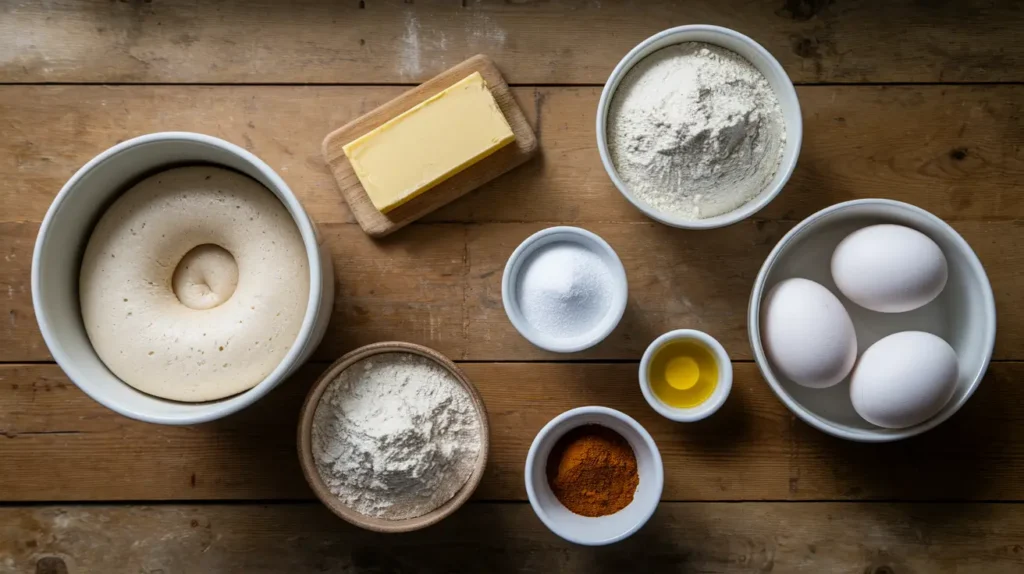Who can resist the warm, gooey delight of sourdough cinnamon rolls? These homemade treats combine the tangy depth of sourdough with the sweet richness of cinnamon sugar, making them an irresistible breakfast or dessert option. Unlike traditional cinnamon rolls, the sourdough version relies on natural fermentation, which enhances flavor, improves texture, and offers gut-friendly benefits.
This guide will walk you through everything you need to know about making soft, fluffy, and perfectly spiced sourdough cinnamon rolls. You’ll discover the best ingredients, step-by-step instructions, baking tips, and troubleshooting hacks to ensure bakery-quality results every time. We’ll also explore common mistakes, storage tips, and health benefits, followed by a handy FAQ section to answer your burning questions.
Let’s dive into the world of sourdough cinnamon rolls—where flavor meets tradition in the most delicious way possible!
Introduction to Sourdough Cinnamon Rolls
What Are Sourdough Cinnamon Rolls?
Sourdough cinnamon rolls are a delicious variation of traditional cinnamon rolls, but instead of using commercial yeast, they’re made with a natural sourdough starter. This not only gives them a unique depth of flavor, but it also makes them easier to digest due to the fermentation process.
Unlike store-bought cinnamon rolls, which can be overly sweet and artificial, sourdough cinnamon rolls offer a slightly tangy, naturally sweet taste with a perfect balance of flavors. Their soft, fluffy texture and buttery cinnamon filling make them an absolute crowd-pleaser.
Why Choose Sourdough Over Commercial Yeast?
The fermentation process in sourdough baking breaks down gluten, making the dough gentler on digestion compared to conventional cinnamon rolls. Plus, sourdough’s natural acidity helps enhance flavor, giving these rolls a light, airy texture that’s hard to beat.
Other benefits of using sourdough starter include:
✔ Longer freshness – Stays soft and moist longer than yeast-based dough.
✔ Better nutrition – Contains prebiotics, lower gluten levels, and improved nutrient absorption.
✔ Enhanced flavor – A slight tang perfectly complements the sweet cinnamon filling.
Brief Overview of the Process
Making sourdough cinnamon rolls involves a few key steps:
- Mixing the dough – Combining a sourdough starter, flour, milk, and eggs for a soft, enriched dough.
- Fermentation – Letting the dough rise slowly to develop flavor and texture.
- Rolling and filling – Spreading a buttery cinnamon-sugar mixture over the dough.
- Shaping and proofing – Rolling the dough into tight spirals and allowing a final rise.
- Baking and frosting – Baking until golden brown and topping with a luscious glaze.
Now that you understand the basics, let’s move on to the essential ingredients and tools you’ll need!
The Science Behind Sourdough Fermentatio
How Sourdough Fermentation Enhances Flavor and Texture
Sourdough fermentation plays a crucial role in making sourdough cinnamon rolls exceptionally flavorful and soft. The natural wild yeast and lactic acid bacteria in the sourdough starter break down complex carbohydrates, creating a deep, tangy flavor profile. This process also develops a tender, airy crumb that enhances the overall eating experience.
Additionally, fermentation helps improve the dough’s extensibility, making it easier to roll and shape without tearing. If you enjoy experimenting with different doughs, you might also like our guide on How to Make Soft and Fluffy Dinner Rolls, where we explore similar techniques for achieving perfect texture.
Health Benefits of Sourdough Fermentation
One of the biggest advantages of making sourdough cinnamon rolls is the health benefits associated with sourdough fermentation. The process reduces phytic acid, which can inhibit nutrient absorption, making minerals like iron and magnesium more bioavailable. Additionally, the prebiotic properties of sourdough support gut health by promoting beneficial bacteria.
Compared to traditional sweet rolls, sourdough cinnamon rolls have a lower glycemic index, which means they cause a slower rise in blood sugar. If you’re interested in more gut-friendly baking, check out our article on Easy Homemade Whole Wheat Bread for another nutrient-rich recipe.
Perfecting the Recipe – Tips and Tricks
Achieving the Perfect Dough Consistency
For soft and pillowy sourdough cinnamon rolls, achieving the right dough consistency is essential. The dough should be slightly sticky but not overly wet. Kneading for the correct amount of time ensures gluten development, which creates a light, structured roll. If your dough feels too dry, adding a small amount of milk or water can help.
Temperature also plays a key role—fermenting in a warm (but not too hot) environment promotes even yeast activity. If you’re interested in working with enriched doughs, our guide on Brioche Bread Baking Tips shares similar techniques that can be applied to cinnamon rolls.
Enhancing Flavor with the Right Ingredients
The choice of ingredients significantly impacts the flavor of sourdough cinnamon rolls. Using high-quality cinnamon, such as Ceylon cinnamon, enhances the natural sweetness, while brown sugar adds a rich, caramel-like depth. Incorporating a touch of vanilla or orange zest into the dough can also elevate the flavor.
To create an extra indulgent experience, consider using a tangy cream cheese frosting. If you love sweet and tangy baked goods, our Lemon Drizzle Cake Recipe offers another delightful treat with a bright citrus kick.
With these techniques, your sourdough cinnamon rolls will turn out perfectly every time. Happy baking! Let me know if you need any refinements or additional internal links.

Baking the Perfect Sourdough Cinnamon Rolls
Preparing Your Dough for Baking
Once your sourdough cinnamon rolls have completed their second rise, it’s time to bake them to golden perfection. Start by preheating your oven to 375°F (190°C). This temperature ensures an even bake, allowing the rolls to rise further and develop a soft, fluffy texture.
Before placing them in the oven, consider brushing the tops with a light egg wash or melted butter. This simple step gives your rolls a beautiful golden-brown finish. If you prefer a softer crust, covering the rolls loosely with aluminum foil halfway through baking can help retain moisture.
Achieving the Perfect Bake
Bake the rolls for 20 to 25 minutes, keeping an eye on them as they turn a rich golden brown. The edges should be slightly crisp, while the centers remain soft and pillowy. To check for doneness, insert a toothpick into the center of a roll—it should come out clean or with just a few moist crumbs.
For an extra indulgent touch, you can brush them with melted butter right after baking. This enhances both flavor and texture, making them irresistibly soft.
Cooling Before Frosting
Once out of the oven, allow your sourdough cinnamon rolls to cool for at least 10 to 15 minutes before applying any icing or glaze. This prevents the frosting from melting completely and ensures a perfect consistency. If you prefer warm, gooey rolls, you can add a light drizzle while they’re still slightly warm.
Frosting and Serving Suggestions
Choosing the Best Frosting
The right frosting can elevate your sourdough cinnamon rolls from delicious to absolutely irresistible. Here are a few classic options:
- Cream Cheese Frosting: A tangy and rich topping made with cream cheese, butter, powdered sugar, and vanilla extract.
- Vanilla Glaze: A simple mixture of powdered sugar, milk, and vanilla extract for a light and sweet finish.
- Maple Butter Glaze: Adds a warm, caramel-like flavor with butter, maple syrup, and powdered sugar.
To achieve the best consistency, beat the ingredients until smooth and spreadable. If you prefer a drizzle instead of a thick layer, add a little extra milk or cream.

Serving and Storage Tips
For the best experience, serve your sourdough cinnamon rolls fresh and slightly warm. Pair them with a cup of coffee or tea for a delightful breakfast or snack.
If you have leftovers, store them in an airtight container at room temperature for up to two days. For longer storage, keep them in the refrigerator for up to a week. Reheat in the microwave for about 15 seconds to restore their soft, fluffy texture.
Final Thoughts
Sourdough cinnamon rolls offer a perfect balance of tangy and sweet flavors, making them a favorite treat for any occasion. Whether you’re baking for a weekend brunch or a holiday gathering, these rolls are sure to impress.
For more delicious recipes, check out other baking articles .
Common Mistakes and Troubleshooting
Even with the best recipe, baking sourdough cinnamon rolls can sometimes lead to unexpected results. Below are some common issues and how to fix them.
Why Are My Sourdough Cinnamon Rolls Not Fluffy?
One of the biggest disappointments when baking is ending up with dense or tough rolls. Here’s why this might happen:
- Underproofing: If the dough hasn’t risen enough, the rolls will be dense. Always let the dough double in size during the first rise and become puffy in the second rise.
- Overproofing: Letting the dough rise too long can cause the rolls to collapse during baking. Stick to the recommended timeframes.
- Not Enough Stretch and Fold: Strengthening the dough during the bulk fermentation stage helps improve its structure and texture.
Avoiding Dry or Hard Rolls
Dry sourdough cinnamon rolls can result from:
- Overbaking: Keep a close eye on the oven to prevent them from drying out. If needed, tent the rolls with foil to prevent excessive browning.
- Not Enough Butter or Sugar in the Filling: A generous amount of butter and sugar helps keep the layers moist and gooey.
- Skipping the Egg Wash or Melted Butter Glaze: Brushing the rolls before and after baking locks in moisture.
Fixing Rolls That Didn’t Rise Properly
If your dough didn’t rise as expected, consider these factors:
- Weak Starter: Ensure your sourdough starter is active and bubbly before using it in the recipe.
- Cold Kitchen: Yeast and bacteria in sourdough thrive in warmth. If your kitchen is too cold, the dough may take much longer to rise.
- Too Much Flour: Adding too much flour can make the dough stiff and difficult to rise. Always measure flour accurately.
By avoiding these mistakes, you’ll achieve light, fluffy, and delicious sourdough cinnamon rolls every time!
FAQs About Sourdough Cinnamon Rolls
Many home bakers have questions about making sourdough cinnamon rolls. Below are answers to some of the most common ones.
Can You Use Sourdough Bread Dough for Cinnamon Rolls?
While it’s possible to use sourdough bread dough, it may not give the soft and tender texture expected in cinnamon rolls. Bread dough has a lower fat content and is usually firmer. For the best results, use a recipe specifically designed for sourdough sweet dough.
What’s the Difference Between Sourdough Cinnamon Rolls and Regular Cinnamon Rolls?
The key difference is the leavening agent:
- Sourdough cinnamon rolls use natural fermentation from a sourdough starter, which gives them a slightly tangy flavor and a longer fermentation process.
- Regular cinnamon rolls rely on commercial yeast for a quicker rise and a more neutral taste.
Why Is Sourdough Bread Healthier Than Regular Bread?
Sourdough is often considered healthier because:
- The long fermentation process helps break down gluten, making it easier to digest.
- It contains prebiotics and probiotics that support gut health.
- Sourdough has a lower glycemic index, leading to better blood sugar control.
How Do You Store and Reheat Sourdough Cinnamon Rolls?
To keep them fresh:
- Store at room temperature for up to 2 days in an airtight container.
- Refrigerate for up to a week if you need a longer shelf life.
- Freeze for up to 3 months and reheat in the oven at 300°F (150°C) for about 10 minutes.
For soft, warm rolls, microwaving for 15-20 seconds works well too!
Creative Variations of Sourdough Cinnamon Rolls
While classic sourdough cinnamon rolls are undeniably delicious, there are many ways to customize them to suit your taste. Whether you want to add extra flavors, use alternative sweeteners, or make them healthier, here are some creative variations to try.
Adding Extra Flavors
If you want to elevate your sourdough cinnamon rolls, consider incorporating these flavor enhancers:
- Chocolate Swirl: Add a layer of melted dark chocolate or chocolate chips to the cinnamon filling for a rich, indulgent twist.
- Apple Cinnamon Rolls: Sprinkle finely diced apples into the filling for a fruity burst of flavor.
- Pumpkin Spice Rolls: Replace some of the cinnamon with pumpkin spice and add a bit of pumpkin purée to the dough for a seasonal treat.
- Nutty Caramel Rolls: Top the rolls with toasted pecans and drizzle with homemade caramel sauce for extra crunch and sweetness.
Healthier Alternatives
If you’re looking for a lighter version of sourdough cinnamon rolls, here are some adjustments:
- Use Whole Wheat Flour: Swap part of the all-purpose flour for whole wheat flour to add fiber and nutrients.
- Reduce the Sugar: Use coconut sugar or honey instead of refined sugar for a natural sweetness.
- Dairy-Free Option: Replace butter with coconut oil and use almond or oat milk for a plant-based version.
- Gluten-Free Sourdough Rolls: While tricky, using a gluten-free sourdough starter and a blend of gluten-free flours can create a softer, allergen-friendly roll.
These variations let you enjoy sourdough cinnamon rolls in new and exciting ways while keeping them as wholesome or indulgent as you prefer.

Conclusion: Enjoying the Perfect Sourdough Cinnamon Rolls
Making sourdough cinnamon rolls from scratch is a rewarding process that brings together the rich, tangy depth of sourdough with the sweet, gooey goodness of cinnamon rolls. From mixing and fermenting the dough to baking and frosting, every step adds to the flavor and texture of these irresistible treats.
By following the right techniques, avoiding common mistakes, and experimenting with creative variations, you can customize your rolls to suit your taste. Whether you prefer a classic cinnamon roll, a chocolate swirl twist, or a healthier whole wheat version, there’s no wrong way to enjoy them!
Plus, with make-ahead options like overnight refrigeration or freezing, you can always have a fresh batch ready for a special breakfast or a cozy afternoon treat.
So, why not get your sourdough starter ready and bake a batch today? Your kitchen will be filled with the warm, comforting aroma of freshly baked sourdough cinnamon rolls, and your taste buds will thank you!
For more delicious baking inspiration, check out our other recipes. Happy baking!

